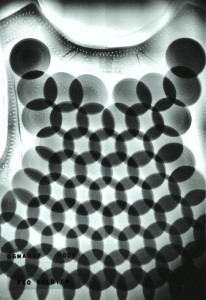If I had a hammer: how a little shrimp packs a mighty punch

 The mantis shrimp is pretty unassuming looking. It's brightly colored, has wacky googly eyes, and is pretty small, about 20 centimeters long. But underwater, the mantis shrimp packs a serious punch. As the paper says: "In stomatopods, the second pair of thoracic appendages is highly modified and specifically adapted for powerful close-range combat." Some of these mantis shrimp have spears, for impaling their prey - those ones are called spearers. Others have clubs, for beating them to death - those are called smashers. Not so unassuming now, eh?
The mantis shrimp is pretty unassuming looking. It's brightly colored, has wacky googly eyes, and is pretty small, about 20 centimeters long. But underwater, the mantis shrimp packs a serious punch. As the paper says: "In stomatopods, the second pair of thoracic appendages is highly modified and specifically adapted for powerful close-range combat." Some of these mantis shrimp have spears, for impaling their prey - those ones are called spearers. Others have clubs, for beating them to death - those are called smashers. Not so unassuming now, eh?
The smashing shrimp can hit things really, really hard for something of their size. They can accelerate to 10,400 g-force and move as fast as 23 meters per second. That's around 50 miles an hour at about the acceleration of a .22 caliber bullet. Serious stuff.
But for a long time, researchers have wondered one thing: how does it slam its claw so hard without breaking itself? Research published in today's issue of Science explains. Turns out, the smasher's claw is quite complex, built for withstanding such blows. To stay intact, the claw is made of three distinct parts:
1. The striking face - that's what it sounds like. The striking face is where the club actually hits the target.
2. The periodic region - behind the striking face is a long thing layer called the periodic region. It's thin, and hard, and has a backing made of something called chitosan that's stacked at different angles - like you might layer a cast. The criss crossing pattern prevents cracking when the club comes down.
3. The striated region - this part goes along the sides of the claw for extra support. The striated region isn't stiff, but holds things without breaking.
Here's a mantis shrimp cracking open a clam with that three part hammer:

So why do we care? Well, figuring out how a little organism can raise its claw, accelerate it like a bullet and bring it down with the force of a speeding car over and over again without breaking could be useful for lots of things, like armor. In fact, we've known about some of these kinds of building techniques for a while. The Romans used "tested" (which translates to tortoise) armor plates that overlapped one another for added strength. They also added layers of wood, crossing their grain patterns, to bolster the armor.
And it's not just the Romans. Today's armor uses layered structures like the mantis shrimp as well. The problem is that even with these layers, the armor wears out and has to be replaced. Maybe, suggests one author, designers could take a lesson from the mantis shrimp's nanoscale building to make resistance better and the life of the armor longer. If we could build nanoscale crystalline structures, rather than large, clumsy, overlapping pieces, we could have lighter, more durable armor.
Via: Science
Image: Mantis Shrimp courtesy of Silke Baron, armor via PEO Soldier
This post was originally published on Smartplanet.com